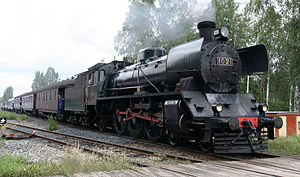VR series Hr1
| VR series Hr1 (until 1942 series P1) | |
|---|---|
|
"Ukko Pekka"
|
|
| Numbering: | VR 1000-1021 |
| Number: | 22nd |
| Manufacturer: | Lokomo , Tampella |
| Year of construction (s): | 1939-1957 |
| Retirement: | until 1971 |
| Axis formula : | 2 'C 1'h2 |
| Gauge : | 1,524 mm |
| Length over buffers: | 22.25 m |
| Height: | 4.65 m |
| Total wheelbase: | 13.56 m |
| Wheelbase with tender: | 18.86 m |
| Empty mass: | 83 Mp |
| Service mass with tender: | 93 Mp |
| Friction mass: | 51 Mp |
| Top speed: | 110 km / h |
| Driving wheel diameter: | 1,900 mm |
| Rear wheel diameter: | 1,120 mm |
| Control type : | Heusinger |
| Number of cylinders: | 2 |
| Cylinder diameter: | 590 mm |
| Piston stroke: | 650 mm |
| Boiler overpressure: | 15 bar |
| Grate area: | 3.54 m² |
| Superheater area : | 68.0 m² |
| Evaporation heating surface: | 195.4 m² |
| Water supply: | 27.0 m³ |
| Fuel supply: | 16.0 m³ |
The VR series Hr1 was a fast train - Train Locomotive of the Finnish State Railways Valtionrautatiet (VR) with the wheel arrangement 2'C1 '. The locomotives were developed and built by Lokomo in Tampere from 1937 . The first copies were initially designated as the P1 series.
history
The Hr1 series was the largest Finnish express steam locomotive and the only VR Pacific locomotive. It was built in several small series from 1939 after two advance copies delivered by Lokomo in 1937.
In October 1942 the VR introduced a new designation system. There the locomotives previously designated as P1 have been sorted into the new Hr1 series. With the exception of eight locomotives, which were supplied by the Tampella locomotive factory, also based in Tampere, in 1955, all locomotives were built by Lokomo. The last two locomotives were delivered in 1957, together with four locomotives of the VR series Tr1 they were the last steam locomotives delivered to the VR. In contrast to the first 20 locomotives, the great Wagner - skirting received, the last two copies were given the small Witte -Windleitbleche. After the former Finnish President Pehr Evind Svinhufvud , who was nicknamed "Ukko Pekka" (in German "Alter Peter"), the Hr1 series was also given this nickname.
Originally intended for coal firing, the Hr1 was fired with wood after the war. In the years from 1947 to 1952, VR had a total of 10 of its steam locomotives converted to oil firing, including a locomotive from the Hr1 series with the number 1005. Until the introduction of the Hr12 series diesel locomotives in 1959, the Hr1 was the most important locomotive for the VR express trains. All examples were officially withdrawn by 1971, but in 1974 two more locomotives were used for a short time. Since the VR kept a total of 250 locomotives of various series as a strategic reserve until the 1980s, even after the official steam locomotive operation ended in 1975, a relatively large number of locomotives remained from the Hr1 that are in museums, for example the railway museum in Hyvinkää , or on museum railways . With the last Hr1 1021 built, the VR also uses a locomotive as a museum locomotive.
In 1939, the Latvian State Railroad Latvijas Valsts Dzelzsceantei also planned to purchase five P1 series locomotives to haul two new pairs of express trains Daugavpils - Riga - Liepāja . The Soviet occupation of Latvia in 1940 prevented the project from being realized.
Kuurila railway accident
The Hr1 1005 was involved in VR's worst train accident in peacetime when it collided with a VR DM4 series multiple unit train heading north near Kuurila in front of a night train going to Helsinki on March 15, 1957 . The accident left 26 dead and over 50 injured, the locomotive was only slightly damaged and repaired.
Individual evidence
- ↑ Mikko Alameri: Railways in Finland , Vienna 1979, p. 45
- ↑ Herman Gjisbert Hesselink, Norbert temple railways in the Baltic States , publishing Lok report, Münster 1996, ISBN 3-921980-51-8 , p 81
literature
- Mikko Alameri: Railways in Finland . Verlag Josef Otto Slezak, Vienna 1979, ISBN 3-900134-22-7


